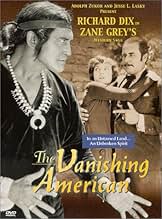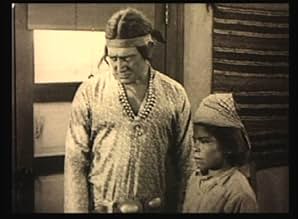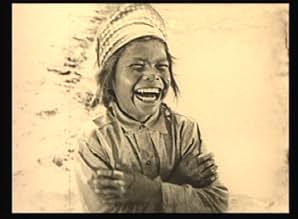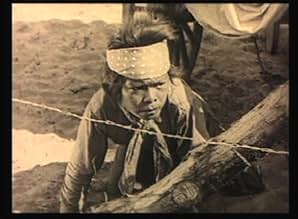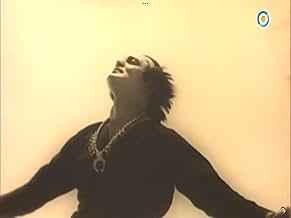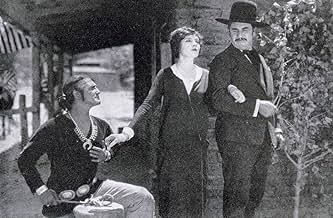A Navajo tribe suffers mistreatment by an Indian-hating agent who steals their horses. When WWI breaks out, a teacher convinces the tribe leader that enlisting will lead to better treatment.A Navajo tribe suffers mistreatment by an Indian-hating agent who steals their horses. When WWI breaks out, a teacher convinces the tribe leader that enlisting will lead to better treatment.A Navajo tribe suffers mistreatment by an Indian-hating agent who steals their horses. When WWI breaks out, a teacher convinces the tribe leader that enlisting will lead to better treatment.
- Director
- Writers
- Stars
- Awards
- 2 wins total
John Webb Dillion
- Naylor
- (as John Webb Dillon)
Gary Cooper
- Extra
- (uncredited)
George Magrill
- The First Nophaie
- (uncredited)
- Director
- Writers
- All cast & crew
- Production, box office & more at IMDbPro
Featured reviews
I remember seeing James Stewart in the 1950 film BROKEN ARROW and being impressed at the positive view of the American Indian shown. Stewart's love (and marriage) for an Indian maidin who is killed by vengeful white men, was powerful and very touching. The 1925 Paramount silent version of Zane Grey's THE VANISHING AMERICAN is even more of an eye-opener! This is not a run of the mill "B" Western as so many of the films based on Zane Grey works were. This is a major Western in the tradition of Paramount's famous 1923 film, THE COVERED WAGON. No film (not even the marvelous films of John Ford)have shown the Indian as he must of lived in former times. The locations are the real thing (and beautifully photographed) and the numbers of extras are huge. One sees hundreds of Indians living in the clift dwellings and riding among the spectacular areas of Arizona and Utah (made famous in the Ford films). The first portion of the film attempts to trace the history of the first people to populate this land and follows their changing conditions through history. Some tribes grow weak and are over-taken by more powerful tribes. Powerful tribes are taken in by the arrival of the white men under Cortez and there first view of a horse (actually THE BOOK OF MORMON, a second testament to Jesus Christ gives a more acurate account of where the horses came from) -- but the Indians believe the horse to be some sort of god and thus subject themselves to the white man. The main story takes up just before American enters World War I and shows the sorry stake of the American Indian, now living on reservations and being cheated out of anything of value that they still have. Richard Dix does a marvelous job playing an Indian who has great values and respect for his people. The film shows the U.S. Governments need and request from the Indians for horses to help in the war. Through Dix's efforts they gain not only horses but enlistment from many of the Indian men. They play an important part in the War effort, but when they return to their land it is to conditions that have worsened, not improved. Thus the climax is set up. Truly an unusal film to survive from the silent era -- and one well worth taking a look at. The surviving material is beautiful to look at, but does contain a degree of flicker caused by the deterioration of the nitrate film that it was printed on. A choice addition to my DVD collection!
Okay, it is very possible to quibble with this film if you are too wrapped up in political correctness. Sure, it's a real shame that the film starred the white actor, Richard Dix, in dark paint as the Indian lead in the film. However, having White actors play Indians was pretty much the rule up to the 1960s, so I could easily overlook this. And, the beginning of the film can seem a tad preachy and irrelevant (though I liked it, Leonard Maltin's Guide knocked this section of the film). However, given that the film was made in the rather racist 1920s (when the KKK was on the rise and one of the strongest political forces in America), it is a truly amazing and transcendent film that definitely deserves to be seen and appreciated.
Unlike the typical cowboy movie of the day, the Indians in the film are neither blood-thirsty savages nor are they simple-minded. Instead, the are uniformly shown as decent Americans who want a fair shake and a part of the American Dream. In fact, their desire to become TRUE Americans and their love of their country make this a great patriotic film. While based on all the horrible injustices they received in the film, their fundamental decency seems amazing.
In addition to excellent acting, writing and direction, special attention must be focused on the spectacular and breathtaking cinematography--especially towards the beginning of the film. The scenes of the Grand Canyon are among the most beautiful ever filmed during the silent era and are in many ways reminiscent of moving versions of Ansel Adams photos. The film is a true work of art.
Unlike the typical cowboy movie of the day, the Indians in the film are neither blood-thirsty savages nor are they simple-minded. Instead, the are uniformly shown as decent Americans who want a fair shake and a part of the American Dream. In fact, their desire to become TRUE Americans and their love of their country make this a great patriotic film. While based on all the horrible injustices they received in the film, their fundamental decency seems amazing.
In addition to excellent acting, writing and direction, special attention must be focused on the spectacular and breathtaking cinematography--especially towards the beginning of the film. The scenes of the Grand Canyon are among the most beautiful ever filmed during the silent era and are in many ways reminiscent of moving versions of Ansel Adams photos. The film is a true work of art.
TThe Vanishing American (1925) - From Paramount Pictures and director George B. Seitz comes this adaptation of Zane Grey's novel. After a lengthy prologue (that's worth the price of admission alone) that details the history of humankind in America, particularly those of the Southwest US, the plot settles in: a devious Indian Affairs agent (Noah Beery Sr.) tries every trick in the book to rip off the Natives on the nearby reservation. He's often thwarted by the stoic Nophaie (Richard Dix), a noble warrior. Nophaie is secretly in love with white schoolteacher Marion (Lois Wilson), but fears that she has her heart set on square-jawed cavalry man Earl Ramsdale (Malcolm McGregor). Also featuring Guy Oliver as Kit Carson, and Nocki as a native boy.
The history and culture portrayed may be dubious, but I admire any attempt at this time to show Native Americans in a positive light. And how many Westerns turn into WWI movies, too? The real star in this one is the scenery, including Monument Valley. Gary Cooper is supposedly an extra in this, but I didn't notice him. This is mainly hokum, but it's enjoyable hokum.
The history and culture portrayed may be dubious, but I admire any attempt at this time to show Native Americans in a positive light. And how many Westerns turn into WWI movies, too? The real star in this one is the scenery, including Monument Valley. Gary Cooper is supposedly an extra in this, but I didn't notice him. This is mainly hokum, but it's enjoyable hokum.
Although by today's standards The Vanishing American is over the top and melodramatic it still has a fine message about the American Indian and their place in the American dream. The sad truth was that this continent did belong to them and we took it from them.
Nothing to be either proud or ashamed of. A society that ranged from hunting and gathering to the beginnings of agricultural gave way to a to an industrial and full blown agricultural society. Just the sociological way of things. Everything gives way to something in time.
That being said, the tragedy of the American Indian was not often told in these years from the Indian point of view. As a writer Zane Grey was steeped in western lore and if a white man could tell the story he could.
After a prologue showing the subjugation, we see the desert tribes of today living on government handouts, trying to maintain respectability but the victims of a corrupt Indian agent played by Noah Beery. That was the way it was back then, under Democratic or Republican administrations, the Department of the Interior was a patronage trough and characters like Noah Beery were more common than we would care to admit.
Richard Dix plays a charismatic leader of his people who actually forms an Indian battalion to fight in what was called then, The Great War. It was reasoned we fight for America as good Americans we'll be treated as such when we return. Instead its business as usual as Beery has banished the tribe to desert scrub lands. Time to return to the fighting ways of our ancestors maybe.
As Dix's character is presented and he specialized in playing noble heroes on the silent screen and when talkies arrived, the personal tragedy of this tribe is that Dix comes along about four generations too late. He's the kind of leader who might have made a difference back in the day, but can only see the futility of what his tribe is about to do.
The Vanishing American shot in what became known as John Ford's Monument Valley was a big budget item for Paramount back in the day. It's got the sweep and grandeur of a John Ford western and a little bit of the influence of Paramount's number one director Cecil B. DeMille in this one who made a spectacle film or two of note.
Though melodramatic, The Vanishing American should still be viewed for the lessons it imparts to today's audience.
Nothing to be either proud or ashamed of. A society that ranged from hunting and gathering to the beginnings of agricultural gave way to a to an industrial and full blown agricultural society. Just the sociological way of things. Everything gives way to something in time.
That being said, the tragedy of the American Indian was not often told in these years from the Indian point of view. As a writer Zane Grey was steeped in western lore and if a white man could tell the story he could.
After a prologue showing the subjugation, we see the desert tribes of today living on government handouts, trying to maintain respectability but the victims of a corrupt Indian agent played by Noah Beery. That was the way it was back then, under Democratic or Republican administrations, the Department of the Interior was a patronage trough and characters like Noah Beery were more common than we would care to admit.
Richard Dix plays a charismatic leader of his people who actually forms an Indian battalion to fight in what was called then, The Great War. It was reasoned we fight for America as good Americans we'll be treated as such when we return. Instead its business as usual as Beery has banished the tribe to desert scrub lands. Time to return to the fighting ways of our ancestors maybe.
As Dix's character is presented and he specialized in playing noble heroes on the silent screen and when talkies arrived, the personal tragedy of this tribe is that Dix comes along about four generations too late. He's the kind of leader who might have made a difference back in the day, but can only see the futility of what his tribe is about to do.
The Vanishing American shot in what became known as John Ford's Monument Valley was a big budget item for Paramount back in the day. It's got the sweep and grandeur of a John Ford western and a little bit of the influence of Paramount's number one director Cecil B. DeMille in this one who made a spectacle film or two of note.
Though melodramatic, The Vanishing American should still be viewed for the lessons it imparts to today's audience.
A great epic. The proof that George B. Seitz was a great director. A very fine cast. Dix and Wilson are outstanding. The story takes you from the time of the dinosaurs to our days in a very convincing way.
Did you know
- TriviaThe legend that John Ford "discovered" Monument Valley (or John Wayne did and Ford took credit for it), or Harry Goulding (the trading post owner there) introduced Ford to this unique location in 1938 for La Chevauchée fantastique (1939), is disproved by the fact that this movie was filmed there in 1925.
- ConnectionsFeatured in The House That Shadows Built (1931)
Details
Box office
- Gross US & Canada
- $286,809
- Runtime1 hour 50 minutes
- Sound mix
- Aspect ratio
- 1.33 : 1
Contribute to this page
Suggest an edit or add missing content


